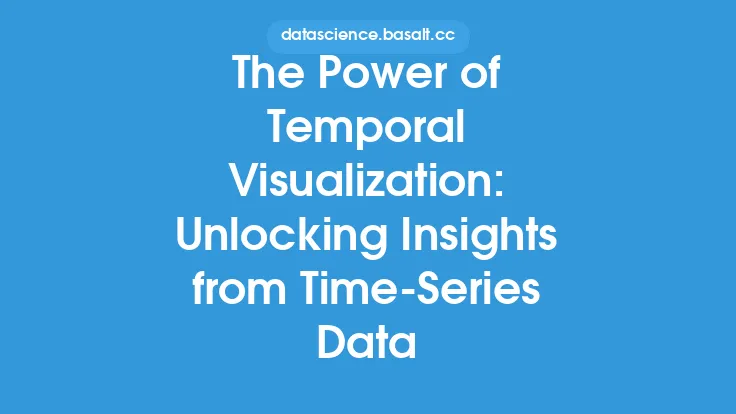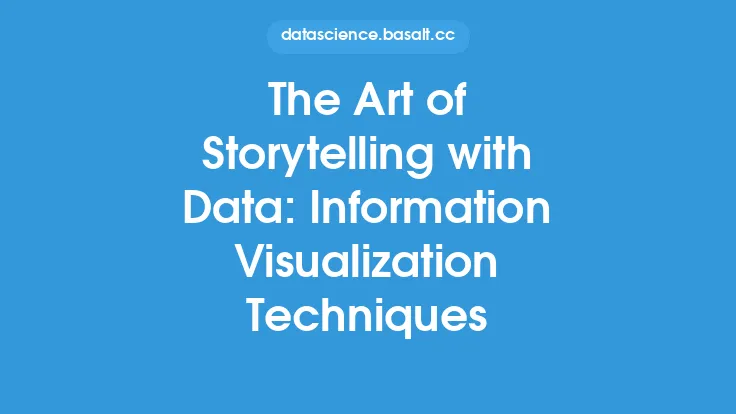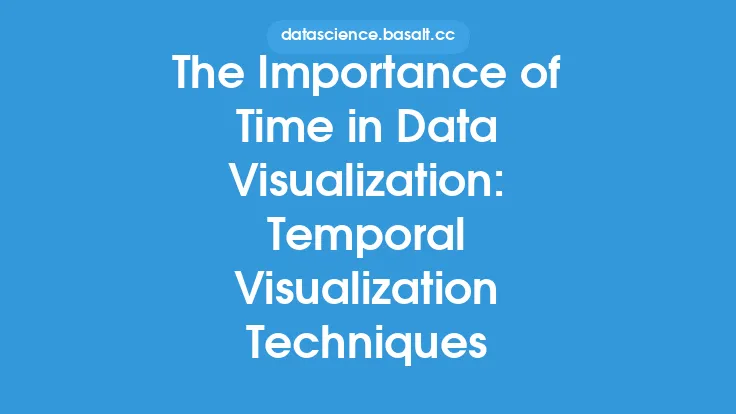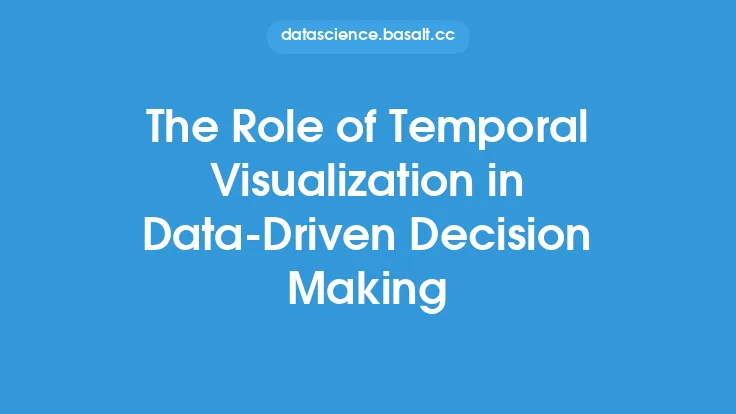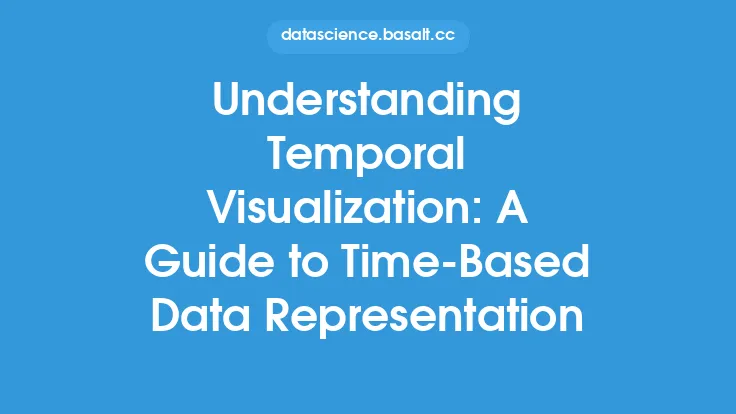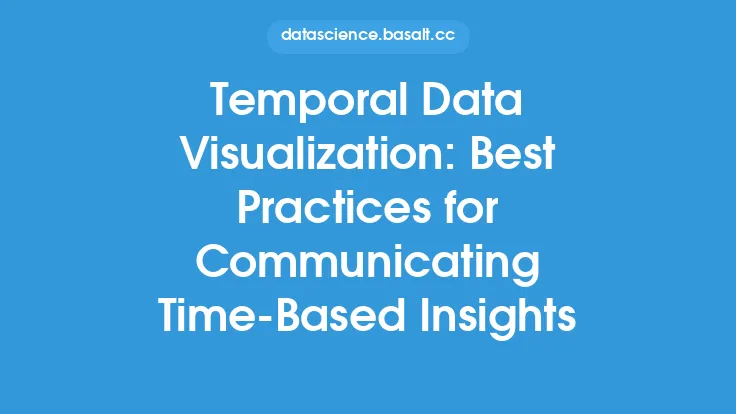The art of storytelling with temporal data is a complex and multifaceted field that has gained significant attention in recent years. As the amount of data being generated continues to grow exponentially, the need to effectively visualize and communicate time-based insights has become increasingly important. Time-based data visualization, also known as temporal visualization, is a specialized field of data visualization that focuses on the representation of data that varies over time. This type of visualization is used to help analysts, scientists, and decision-makers understand and extract insights from complex temporal data.
Introduction to Temporal Visualization
Temporal visualization is a critical component of data analysis, as it allows users to identify patterns, trends, and correlations in time-based data. By visualizing temporal data, users can gain a deeper understanding of how events unfold over time, and how different variables interact and influence one another. Temporal visualization can be applied to a wide range of fields, including finance, healthcare, climate science, and social media analysis. The goal of temporal visualization is to create interactive and dynamic visualizations that facilitate the exploration and analysis of time-based data.
Types of Temporal Data
There are several types of temporal data, each with its own unique characteristics and challenges. The most common types of temporal data include:
- Time-series data: This type of data is measured at regular intervals over time, such as stock prices, weather patterns, or website traffic.
- Event-based data: This type of data is generated by specific events, such as transactions, clicks, or sensor readings.
- Interval-based data: This type of data is measured over a specific period, such as daily, weekly, or monthly sales.
- Spatial-temporal data: This type of data combines spatial and temporal information, such as the movement of people, vehicles, or objects over time.
Visualization Techniques for Temporal Data
There are several visualization techniques that can be used to effectively communicate temporal data. Some of the most common techniques include:
- Line charts: These are used to show trends and patterns in time-series data.
- Bar charts: These are used to compare values over time, such as daily or monthly sales.
- Scatter plots: These are used to show the relationship between two variables over time.
- Heatmaps: These are used to show the distribution of values over time, such as website traffic or social media engagement.
- Interactive visualizations: These allow users to explore and interact with temporal data in real-time, such as zooming, filtering, and hovering.
Best Practices for Temporal Visualization
To create effective temporal visualizations, there are several best practices to keep in mind. These include:
- Using a clear and consistent timeline: This helps users understand the context and relationships between different events and variables.
- Selecting the right visualization technique: Different techniques are better suited to different types of temporal data and analysis tasks.
- Using color and other visual encodings effectively: Color, size, and shape can be used to encode different variables and highlight important patterns and trends.
- Providing interactive tools: Interactive visualizations allow users to explore and analyze temporal data in real-time.
- Using storytelling techniques: Temporal visualizations can be used to tell a story about the data, highlighting key insights and findings.
Technical Considerations for Temporal Visualization
When creating temporal visualizations, there are several technical considerations to keep in mind. These include:
- Data storage and management: Temporal data can be large and complex, requiring specialized storage and management solutions.
- Data processing and analysis: Temporal data requires specialized processing and analysis techniques, such as time-series analysis and event detection.
- Visualization libraries and tools: There are several visualization libraries and tools available for creating temporal visualizations, such as D3.js, Matplotlib, and Tableau.
- Scalability and performance: Temporal visualizations can be computationally intensive, requiring optimized code and scalable architectures.
Applications of Temporal Visualization
Temporal visualization has a wide range of applications across various fields, including:
- Finance: Temporal visualization is used to analyze stock prices, trading volumes, and market trends.
- Healthcare: Temporal visualization is used to analyze patient outcomes, disease progression, and treatment efficacy.
- Climate science: Temporal visualization is used to analyze weather patterns, climate trends, and environmental changes.
- Social media analysis: Temporal visualization is used to analyze social media engagement, sentiment, and trends.
Future Directions for Temporal Visualization
The field of temporal visualization is rapidly evolving, with new techniques, tools, and applications emerging all the time. Some of the future directions for temporal visualization include:
- Increased use of machine learning and artificial intelligence: These technologies can be used to automate the analysis and visualization of temporal data.
- Greater emphasis on storytelling and communication: Temporal visualizations can be used to tell compelling stories about the data, highlighting key insights and findings.
- Increased use of virtual and augmented reality: These technologies can be used to create immersive and interactive temporal visualizations.
- Greater emphasis on scalability and performance: As the amount of temporal data continues to grow, there will be a greater need for scalable and performant visualization solutions.
